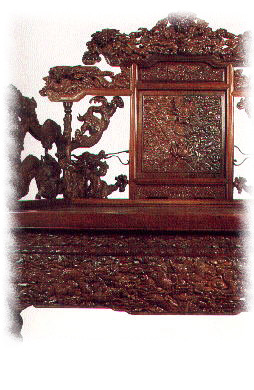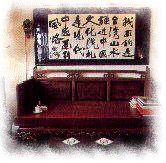Design Arts -- Furniture
Tradition
The development of traditional Chinese furniture went from the simple to the intricate and was closely linked to the Chinese lifestyle and to cultural and economic changes in China as well. In ancient times, the Chinese sat mostly on straw mats on the floor. After the Warring States period (475-221 B.C.), beds and couches began to come into widespread use for seating. During the Wei-Chin (220-420 A.D.) and the Northern and Southern dynasties (420-589 A.D.) period, Western-style chairs, folding stools, and other seating gradually entered China. From that point on, Chinese everyday living began to be conducted from chairs rather than sitting cross-legged on the floor.
Beginning in the late Ch'ing Dynasty (1644-1911 A.D.), foreign living styles began to be adopted in China, and as a result originally predominant Chinese-style furnishings gradually became collector's items. Not only chairs, but also Chinese tables, cabinets, bookcases, and decorative screens reached the height of their development during the Ming (1368-1644 A.D.) and Ch'ing dynasties.
Ming furniture features simple, smooth, and flowing lines, and plain and elegant ornamentation which fully bring out the special qualities of frame-structure furniture. Influenced by China's burgeoning foreign trade and advanced craftsmanship techniques, furniture of the Ch'ing Dynasty period turned to rich and intricate decoration with coordinated engraved designs.

|
Bamboo and rattan furniture also have a long history. Bamboo is a product unique to Asia. Simple and ingenious techniques are used to make clever and useful modular pieces that can be used together or separately. Bamboo is used in combination with other materials, such as wood, rattan, metal, and ceramic tile, in endless variation. A great deal of bamboo and rattan furniture is exported to Europe and the United States, where it is extremely popular.
Chinese are fond of furniture with inlaid and carved work. In addition to shells and enamel chips, brilliant, colorful, and artistically grained jade, stones, ivory (and other animal teeth), horn, agate, and amber have been used since bygone times for inlaid designs. Marble is an example of stone often used for inlaid work. Colorful ceramic plates are also a popular material for beautification. Another elegant technique used since ancient times is the inlaying of different types and colors of woods in a single piece. The methods of carving include relief carving, negative engraving, and free-style carving. Common subjects for furniture carving are the symbols popular to the Chinese culture such as flowers, dragons, phoenixes, the ch'ilin which is a mythical Chinese beast, and stylized cloud and leaf patterns.
Today

|
With China's increasing economic prosperity, more and more people are placing great importance on interior design and room arrangement. With this prosperity, more people are also becoming very particular when choosing furniture. And because of a corresponding enhancement in spiritual life, traditional Chinese style furniture now enjoys a special vogue. Many like to collect and use traditional Chinese furniture in all sorts of ways in their homes; it has become part of the modern lifestyle.



 Chinese Culture
Chinese Culture